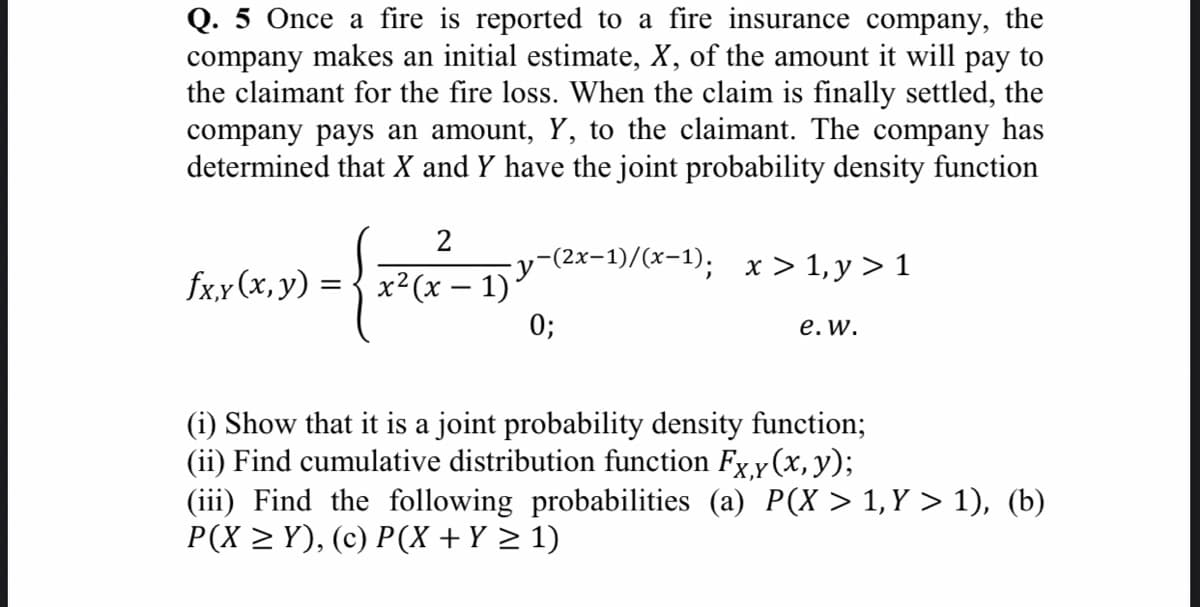Q. 5 Once a fire is reported to a fire insurance company, the company makes an initial estimate, X, of the amount it will pay to the claimant for the fire loss. When the claim is finally settled, the company pays an amount, Y, to the claimant. The company has determined that X and Y have the joint probability density function (2x-1)/(x-1); x > 1, y > 1 fx.x (x, y): x²(x – 0; е. w. (i) Show that it is a joint probability density function; (ii) Find cumulative distribution function Fxy(x, y); (iii) Find the following probabilities (a) P(X > 1, Y > 1), (b) P(X > Y), (c) P(X + Y > 1)
Q. 5 Once a fire is reported to a fire insurance company, the company makes an initial estimate, X, of the amount it will pay to the claimant for the fire loss. When the claim is finally settled, the company pays an amount, Y, to the claimant. The company has determined that X and Y have the joint probability density function (2x-1)/(x-1); x > 1, y > 1 fx.x (x, y): x²(x – 0; е. w. (i) Show that it is a joint probability density function; (ii) Find cumulative distribution function Fxy(x, y); (iii) Find the following probabilities (a) P(X > 1, Y > 1), (b) P(X > Y), (c) P(X + Y > 1)
Chapter6: Exponential And Logarithmic Functions
Section6.8: Fitting Exponential Models To Data
Problem 56SE: Recall that the general form of a logistic equation for a population is given by P(t)=c1+aebt , such...
Related questions
Question

Transcribed Image Text:Q. 5 Once a fire is reported to a fire insurance company, the
company makes an initial estimate, X, of the amount it will pay to
the claimant for the fire loss. When the claim is finally settled, the
company pays an amount, Y, to the claimant. The company has
determined that X and Y have the joint probability density function
2
-(2x-1)/(x-1); x > 1, y > 1
fx,x (x,y) =
x²(x – 1)'
0;
е. w.
(i) Show that it is a joint probability density function;
(ii) Find cumulative distribution function Fx,y(x, y)
(iii) Find the following probabilities (a) P(X > 1, Y > 1), (b)
P(X > Y), (c) P(X + Y > 1)
Expert Solution
This question has been solved!
Explore an expertly crafted, step-by-step solution for a thorough understanding of key concepts.
This is a popular solution!
Trending now
This is a popular solution!
Step by step
Solved in 2 steps

Knowledge Booster
Learn more about
Need a deep-dive on the concept behind this application? Look no further. Learn more about this topic, statistics and related others by exploring similar questions and additional content below.Recommended textbooks for you


Glencoe Algebra 1, Student Edition, 9780079039897…
Algebra
ISBN:
9780079039897
Author:
Carter
Publisher:
McGraw Hill


Glencoe Algebra 1, Student Edition, 9780079039897…
Algebra
ISBN:
9780079039897
Author:
Carter
Publisher:
McGraw Hill